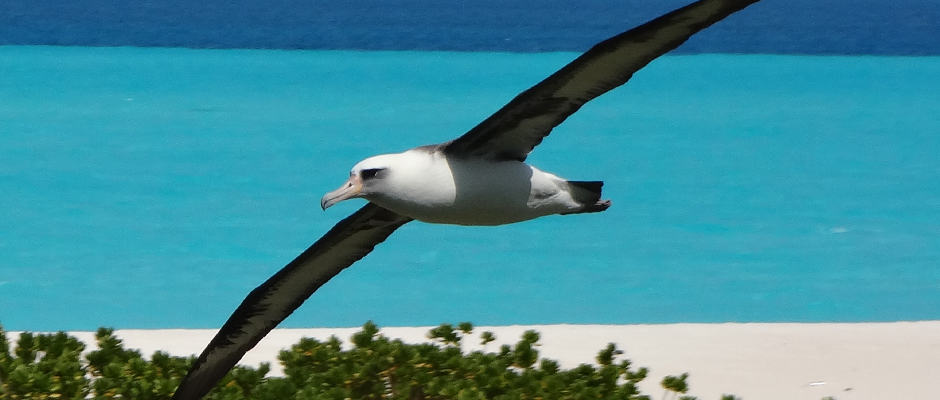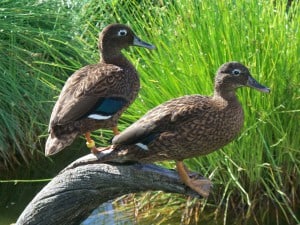Share this article
Hard Work in Paradise: A Profile of a Midway Atoll Biologist
It was the middle of a traditional ceremony to maintain cultural ties to a tiny atoll, which sits on the northwest of the Hawaiian archipelago about a third of the way from Honolulu to Tokyo in the Pacific Ocean. One of the Hawaiian traditional practitioners was chanting in a circle that included several U.S. Fish and Wildlife Service biologists who had been working to conserve native species, eradicate invasives and return Midway Atoll National Wildlife Refuge within the Papahānaumokuākea Marine National Monument to some semblance of what it might have been before decades of cosmetic landscaping and a world war had transformed the 2.4-square mile landscape. Part of the ceremony included participants sharing a small coconut shell filled with ‘awa — a traditional, mildly sedative drink that has a numbing effect on the lips — when a Laysan duck (Anas laysanensis) wandered into the circle.
“Having the Laysan duck enter the circle was magical and a culmination of some of the major conservation restoration activities to date,” said John Klavitter, then a biologist and deputy refuge manager at the atoll. One of the many projects he’d been involved with on Midway Atoll had been the reintroduction of the endangered Laysan duck. In the mid-2000s, Klavitter and other researchers had created wetlands and translocated ducks to the atoll. The project was ultimately successful — today there are around 350 Laysan ducks on Midway — but the timely appearance of the duck during the ceremony seemed to represent the retying of severed past connections. The bird entered the ceremony, looked around inquisitively, then slowly slipped into native bunch grass that Klavitter and others had also been working to restore.
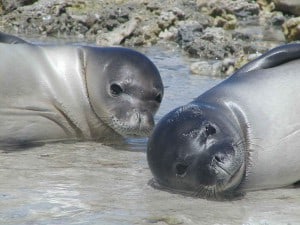 After nearly 12 years on a remote atoll in the middle of the Pacific Ocean, Klavitter knows the meaning of hard work in paradise. He grew on the Mississippi River, thousands of miles from an ocean, reading Tom Sawyer and Huck Finn.
After nearly 12 years on a remote atoll in the middle of the Pacific Ocean, Klavitter knows the meaning of hard work in paradise. He grew on the Mississippi River, thousands of miles from an ocean, reading Tom Sawyer and Huck Finn.
“I’ve been drawn all my life to unique natural areas and resources,” he said. Klavitter eventually got a job with the National Marine Fisheries Service in Hawaii working on Hawaiian monk seals (Neomonachus schauinslandi) and met his wife, Leona Laniawe, while they were working together. He then got a job with the USFWS where he worked on recovering the endangered Hawaiian crow (Corvus hawaiiensis) and assessing the status of the endangered Hawaiian hawk (Buteo solitarius).
“The opportunity for us to work on Midway Atoll presented itself, and fortunately, the stars aligned.”
Midway Atoll
While the atoll may be small, it has seen its share of drama. Shipwrecked sailors wound up there in the 1800s and then the U.S. Navy took over in the beginning of the 20th century. The Battle of Midway was the scene of a major victory of the U.S. against the Japanese forces in World War II and the military continued to control the island for decades. During this time, the Americans that lived on the island brought in foreign soil to create green lawns like they had back home on the mainland U.S.
“Soil was brought in, ironwood trees, grass seed, and many other non-native plants and invertebrates” Klavitter said, adding that rats and mice were also introduced. “They were excited to have lawns, gardens, shade trees, and even a golf course out there.”
But the imported soil — around 1,000 tons — carried the seeds of invasive plants and insects that took hold and still have a grip on a portion of the atoll. Australian pines (Casuarina spp.), for instance, that were brought in to break the winter winds, are somewhat widespread on Sand Island. “We have successfully removed them from Eastern and Spit islands and are removing a portion of them from Sand Island according to our management plan,” Klavitter said. The storm winds are strong enough to blow over multiple trees during the winter months, which crush adult albatrosses and their nests as well as other seabird species that make up the roughly 3 million birds that live on the atoll. “[The trees] are not so compatible with the ecosystem.”
Eventually the military scaled back its operations and invited the USFWS to establish an “overlay” National Wildlife Refuge in 1988 as it recognized the importance of wildlife, Klavitter said. In 1993, the Navy decided to close its base and initiated “clean up” activities, which included funding a program to eradicate invasive black rats from the atoll. Three years later the atoll and its surrounding waters became a “stand alone” National Wildlife Refuge. Where there were once some 5,000 people on the island, but after the military left, there are now between 45 and 60 USFWS staff and volunteers, as well as scientists, contractors and other support staff.
Controlling Egrets
One of the ongoing jobs Klavitter was involved with after moving to the island in 2002 was the control of invasive cattle egrets (Bubulcus ibis). The birds had been introduced to the main Hawaiian Islands in 1959 to control insects on ranches but they can potentially impact seabird chicks and Laysan ducks by preying on ducklings. Large flocks of egrets can be a hazard for the airfield on the island, which is maintained by USFWS and the Federal Aviation Administration as an emergency landing strip for all the twin-engine commercial airliners that transit the Pacific.
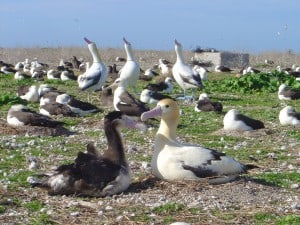
A short-tailed albatross alongside decoys set up to help a lone male that turned up attract a mate to the island. Image Credit: John Klavitter
But the egrets were very smart, he said, and managing them was complicated because of the large number of seabirds that were also on the island. “We had a 22 with a silencer and a scope,” Klavitter said, adding that they chose their shots carefully, often shooting from a high location toward the ground for the safety of other wildlife. “You needed to put on camouflage gear and oftentimes crawl on your belly to sneak up close enough for the perfect shot.”
The biologists would also use other tactics, involving combing the small islands in search of egret nests and removing their eggs, or poking holes in the ones that were there so the egrets would continue to incubate non-viable eggs and not lay new ones.
The efforts worked, and biologists managed to reduce the population of the egrets from approximately 70 to less than 10 at one point, but the numbers have begun to increase again due to reduced USFWS staffing and capacity.
The Wingmen of the Short-Tailed Albatross
At one point, the short-tailed albatross (Phoebastria albatrus) was a numerous albatross in the Pacific but was hunted almost to extinction, with only a small population remaining on a Japanese island called Torishima. The historic population of short-tailed albatross at Midway is not known, however, there were annual sightings of up to four birds since 1938. Then, in 1999, biologists pinned their hopes on a lone male that ventured on to the atoll. They set out on a program to help the male attract a mate, setting up some 42 decoys with a large portion donated by the Japanese government in 2000. They also brought courting into the age of virtual dating, setting up a solar powered social attraction system with speakers to play recordings of courtship calls “to increase the odds of birds meeting each other when they’re flying over.”
It wasn’t necessarily easy work, as Klavitter said that majority of seabirds are hardwired to return to nest in areas close to where they hatch. It’s only a very small percentage that will set out to find new island homes.
But eight years of amplifying the bird’s reproductive charm paid off when a female finally turned up in 2008. The first egg was laid in November 2010 and the couple has had three successful chicks so far, though the initial male has since died.
A Capital Future
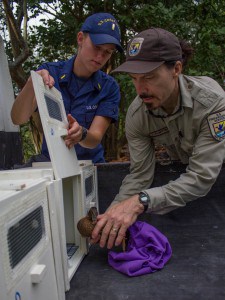
John Klavitter helps to translocate a Laysan duck destined for Kure Atoll from Midway Atoll. Image Credit: Eric Dale
Klavitter enjoyed a great connection with nature out in the Pacific. He recalls one of the most unique experiences of the island was being investigated by an albatross as he lay flat on the ground just off a trail in the colony. Some of the three species of albatross that live on the island evolved without terrestrial predators and therefore have little or no fear of people, and he said they will come up to you and tug at your clothes with their bills and pull on your shoelaces.
“They approach you with no fear, curiosity, and trust in their eyes.”
But while he and his wife loved the work they were doing, they thought it would be a great opportunity to move to the Washington, D.C. area and share what they’ve learned at a national level. Thanks in part to his work clearing the islands of invasive wildlife and plants, Klavitter is now the National Invasive Species Coordinator for the National Wildlife Refuge System.
“There’s a lot closer connection to policy here,” he said.
But he still maintains a connection to the tiny atoll, saying he returned last year to co-lead the translocation of 28 immature Laysan ducks from Midway to Kure Atoll about 55 miles away to initiate a third wild population as part of the recovery plan for the species.
Header Image: Laysan albatross. Image Credit: John Klavitter



